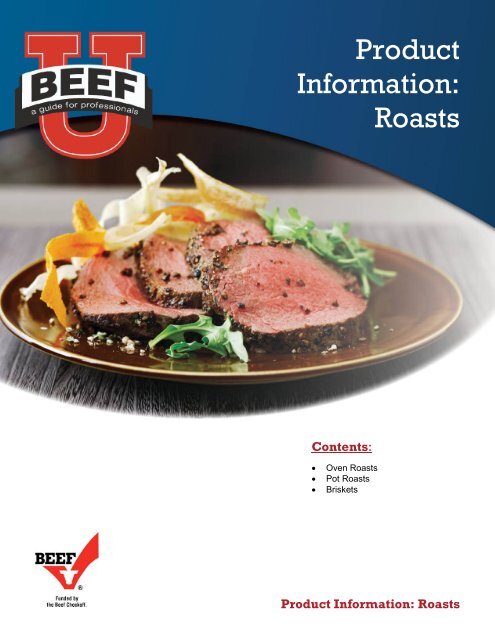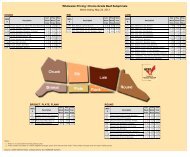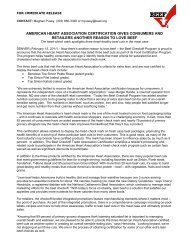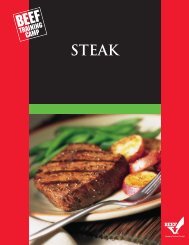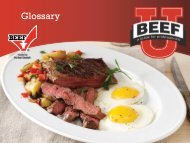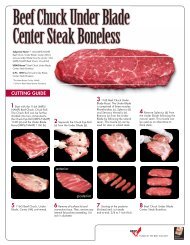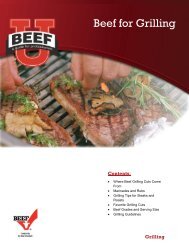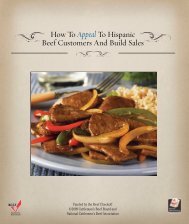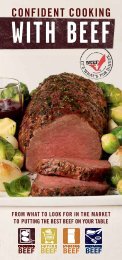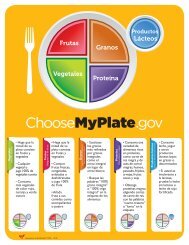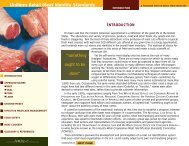Fact Sheet - Beef Foodservice
Fact Sheet - Beef Foodservice
Fact Sheet - Beef Foodservice
- No tags were found...
You also want an ePaper? Increase the reach of your titles
YUMPU automatically turns print PDFs into web optimized ePapers that Google loves.
ProductInformation:RoastsContents:• Oven Roasts• Pot Roasts• BrisketsProduct Information: Roasts
Definition of a Roast• A cut of beef more than two inches thick and larger than a steak. It may containbone and is often comprised of more than one major muscle.• Tender roasts from the rib and loin are recommended for dry heat cooking (ovenroast or in a covered grill using indirect heat)• Less tender beef roasts from the chuck and round are called pot roasts and arerecommended for moist heat cooking (slow cooker or braising)General Oven Roast InfoOven roasting is a way of cooking by dry heat, resulting in a beautiful outside andtender, juicy inside. Typically, the most tender beef cuts are those that are preparedusing this dry heat cooking method, with <strong>Beef</strong> Rib being the most popular, followed by<strong>Beef</strong> Tenderloin.Both of these popular cuts offer a choice in portion size and can be sliced to differentthickness, which means your menu can have a range of portion sizes to satisfy varyingpatron tastes. It also allows you to offer large portion specials when needed, makingyour menu flexible and versatile.Oven roasts are ideal for dishes prepared with a special rub, sauce or seasoning.Customers are often willing to pay a premium for a “signature” items, and oven-roastedbeef roasts provide the stunning presentation and memorable experience thatconsumers crave.Another benefit to oven roasts is the multitude of ways in which they can be used. Inaddition to traditional applications, surprise and delight your customers with a variety ofmenu additions utilizing roasts:• <strong>Beef</strong> up breakfast with dishes like Roast <strong>Beef</strong> Hash, South-of-the-BorderScramble, <strong>Beef</strong> Biscuits and Gravy, or a Breakfast <strong>Beef</strong> Burrito• Add to appetizers with Roast <strong>Beef</strong> Sliders, <strong>Beef</strong> and Asparagus Roll-Ups or <strong>Beef</strong>and Sun-Dried Tomato Toasts• Extend soups like <strong>Beef</strong> & Barley or Minestrone with the addition of diced roastbeef• Create salad specials like a Greek <strong>Beef</strong> Salad, Roast <strong>Beef</strong> Caesar, CowboyCobb, Thai <strong>Beef</strong> Salad or Roast Nicoise• Offer entrée specials using roast beef: pasta, pizza, Santa Fe-Style Roast <strong>Beef</strong>with southwestern spices, or Kung Pao <strong>Beef</strong>Cooking a Perfect Oven Roast• Season with an herb rub• Roast or grill• Place on rack in shallow roasting pan when preparing in an oven• Do not add water and do not cover• Cook between 325 o F and 425 o F depending on roast• Use an ovenproof meat thermometer to check doneness
Premium vs. ValuePremium Roasts• Tenderloin Roast• Rib Roast• Ribeye Roast• Strip RoastValue Roasts• Top Sirloin Roast• Tri-Tip Roast• Round Roast• Round Rump (Steamship, Baron of <strong>Beef</strong>)• Sirloin Tip Roast• Outside Round (Flat)Tenderness Ranking—Oven RoastsThe most tender beef oven roasts, in order from most tender, are:• Tenderloin• Strip Roast• Ribeye RoastNutrition Lean List—Oven RoastsThe leanest beef oven roasts, in order from most lean, are:• Round Roast• Top (Inside) Round Roast• Top Sirloin Roast• Brisket Flat• Sirloin Tip Center Roast• Round Rump Roast (Steamship, Baron of <strong>Beef</strong>)• Arm Chuck Roast• Outside Round (Flat) Roast• Tri-Tip Roast• Tenderloin RoastIndividual Cut Information—Oven RoastsChuck116H <strong>Beef</strong> Chuck, Chuck Eye (IM)• This muscle group is an extension of the Ribeye• Sometimes referred to as the “mock Ribeye”Rib—Bone In(<strong>Beef</strong> Standing Rib, <strong>Beef</strong> “Prime” Rib)107 <strong>Beef</strong> Rib, Oven-Prepared109 <strong>Beef</strong> Rib, Roast-Ready109A <strong>Beef</strong> Rib, Roast-Ready, Special (feather bones removed)
109D <strong>Beef</strong> Rib, Roast-Ready, Cover Off, Short-Cut (Export Style)109E <strong>Beef</strong> Rib, Ribeye Roll, Lip-On, Bone In (Export Style)• Most regal and classic of beef roasts, ranging from 14 to 22 pounds• Flavorful, bone-in cut offers dramatic appearance• Exceptional taste and tenderness• “Prime Rib” signifies the first seven beef ribs between the chuck and the shortloin; most popular menuing application for the beef rib cut• The term “prime” used with this cut many times does not indicate the grade U.S.Prime• Another impressive application involves cutting off a portion from the roast,adding a dry rub and then grilling to order, creating 2 menu items when you offer“Prime” Rib and Cowboy SteakRib—Boneless(<strong>Beef</strong> Ribeye Roast, Boneless <strong>Beef</strong> “Prime” Rib, Boneless <strong>Beef</strong> Rib Roast)110 <strong>Beef</strong> Rib, Roast-Ready, Boneless112A <strong>Beef</strong> Rib, Ribeye, Lip On112 <strong>Beef</strong> Rib, Ribeye Roll112C <strong>Beef</strong> Rib, Ribeye (IM)• Most often used for “Prime” Rib menu options because this boneless itemis easier to vary portion size• Convenient and versatile• Perfect for menuing several portion sizes and varying degrees of doneness• Excellent for buffet service or carving at the guest table• Boneless cut can be sliced into steaks of any thickness or served as a hot buffetroastLoin(<strong>Beef</strong> Tenderloin Roast, Chateaubriand, Filet Mignon Roast)189, 189A <strong>Beef</strong> Loin, Tenderloin, Full190, 190A <strong>Beef</strong> Loin, Tenderloin, Full, Side Muscle Off, Defatted191, 191A, 191B <strong>Beef</strong> Loin, Tenderloin, Butt192 <strong>Beef</strong> Loin, Tenderloin, Short• A menu superstar• The most tender beef cut• Premium, classic, well-loved• Easy to portion and prepare, weighing from 2 to 7 pounds• Perfect for carving stations• PSMO: another name for the full tenderloin with the side muscle on and alloutside fat removed (IMPS/NAMP 189A)• Silver Skin: connective tissue that surrounds the major tenderloin muscle• Peeled: all outside fat and connective tissue removedLoin(<strong>Beef</strong> Strip Loin)175 <strong>Beef</strong> Loin, Strip Loin, Bone In180 <strong>Beef</strong> Loin, Strip Loin, Boneless
• Typically cut into steaks, but can also be roasted• Range from 8 to 14 pounds• Among the top five most tender beef cuts• Highly valued cutsSirloin(<strong>Beef</strong> Sirloin, <strong>Beef</strong> Top Butt)184, 184A <strong>Beef</strong> Loin, Top Sirloin Butt, Boneless184B <strong>Beef</strong> Loin, Top Sirloin Butt, Center-Cut, Boneless, Cap Off (IM)184D <strong>Beef</strong> Loin, Top Sirloin, Cap (IM)184E <strong>Beef</strong> Loin, Top Sirloin Butt, Boneless, 2-piece (184B +184D)184F <strong>Beef</strong> Loin, Top Sirloin Butt, Center Cut, Boneless, Seamed, 2-Piece (smaller piecereferred to as Baseball Cut)• Boneless cut located between the short loin and round, separated from theBottom Sirloin through a natural seam• Cooked as a roast for sandwiches and sliced beef salad185B <strong>Beef</strong> Loin, Bottom Sirloin Butt, Ball Tip, Boneless (IM) (<strong>Beef</strong> Ball Tip, <strong>Beef</strong> Sirloin)• Less tender than Top Sirloin185C, 185D <strong>Beef</strong> Loin, Bottom Sirloin Butt, Tri-Tip, Boneless (IM) (<strong>Beef</strong> Tri-Tip)• A west coast favorite and one of the “best kept secrets”• Classic cut grilled in the Santa Maria BBQ• Triangular shape provides varying degrees of doneness• Can be roasted, grilled, broiled or done on the rotisserie• A multitude of serving ideas: sliced with sauce or relish, in sandwiches, asLondon Broil, as beef hash, or sliced in BBQRound166B <strong>Beef</strong> Round, Rump and Shank Partially Off, Handle On (Baron of <strong>Beef</strong>,Steamship Round)• A classic• Impressive for carving stations or hot buffets168 <strong>Beef</strong> Round, Top (Inside), untrimmed169 <strong>Beef</strong> Round, Top (Inside)169A <strong>Beef</strong> Round, Top (Inside), Cap Off• Buffet carving classic• Leftovers great for use in sandwiches or salads167 <strong>Beef</strong> Round, Knuckle (Tip)167A <strong>Beef</strong> Round, Knuckle (Tip), Peeled167D <strong>Beef</strong> Round, Knuckle (Tip), Peeled, 2-Piece (167E +167F)167E <strong>Beef</strong> Round, Knuckle (Tip), Center Roast (IM)• One of the three major muscle groups in the round• Works with dry or moist heat cooking methods• Great when thinly sliced for sandwiches• More economical cut
171B <strong>Beef</strong> Round, Outside Round (Flat)171D <strong>Beef</strong> Round, Outside Round, Side Muscle Removed (IM)• Works well with slow roasting/barbecue or moist heat cooking• Great for stews, shredded for tamales, hash and cassoulet• Tenderizing is recommended• More economical cut171C <strong>Beef</strong> Round, Eye of Round (IM) (<strong>Beef</strong> Eye Round)• Works with dry or moist heat cooking methods• A smaller roast, great when sliced for sandwiches• More economical cutGeneral Pot Roast Info“Cooking under cover, “also known as braising or stewing, relies on the steam fromsimmering liquid to turn less tender cuts of beef into richly flavored, fork-tender favorites.It’s a time-tested tradition of cooking that’s making a comeback as part of the comfortfoods trend.Less tender cuts are ideal for braising or stewing. To determine a cut’s tenderness, firstlook at the amount of connective tissue—less tender cuts have a larger amount ofconnective tissue. Next, look at the location of the cut. Cuts that have been taken fromthe front and rear of the animal, such as the chuck and the round, have been moreheavily exercised and, therefore, can be less tender.The key to successful braising or stewing is gentle simmering with a cover. Using a lowtemperature over the proper length of time converts the collagen (a type of connectivetissue) into tender gelatin. Brown beef in a heavy bottomed pan to add flavor. Add liquid:broth, water, juice, beer or wine. Cook in a tightly covered pan for 2 to 3 hours in oven,on low heat, on stove top or in slow cooker. Use braising juices to create gravy. Use afork to test if the meat is done to perfection.Here are some benefits to cooking under cover:• A large supply of economical beef cuts that are easy to prepare in large volumesmake it both convenient and appropriate for regular and takeout menus• It’s easy to create “signature dishes” that have a great presentation and areunique• The complex, intense flavors of the cooking liquid are ideal for full-bodied, richsauces• By varying your technique, you can create a host of dishes: Mexican shreddedbeef to Italian Braciola to Yankee Pot Roast• Customers crave the unbeatable, rich flavor and taste of “home cooked” meals• Nothing evokes memories like a good, old-fashioned pot roast—right on trendwith comfort foods• Braised beef holds and reheats well for leftovers
Nutrition Lean List—Pot RoastsThe leanest beef pot roasts, listed in order from most lean, are:• Eye of Round Roast• <strong>Beef</strong> Round, Bottom Round, Heel• <strong>Beef</strong> Round, Knuckle (Tip)• <strong>Beef</strong> Round, Outside Round• Arm Chuck RoastIndividual Cut Information—Pot RoastsChuck114, 114C <strong>Beef</strong> Chuck, Shoulder (Clod)114E <strong>Beef</strong> Chuck, Shoulder (Clod), Arm Roast PSO1 (<strong>Beef</strong> Clod Heart or <strong>Beef</strong> ShoulderCenter Roast)• Weighs 13 to 21 pounds; contains two major muscle groups that are among thetop five most tender muscles in the entire carcass• 114E consists of the large muscle system of the thick end of the clod; menu asmock brisket or pot roast• Offers operators value because it’s an economical cut that can be used in avariety of entrees: pot roasts, stews, soups, stroganoff, shredded fillings for tacosand sandwiches116A <strong>Beef</strong> Chuck, Chuck Roll116B <strong>Beef</strong> Chuck, Chuck Tender (<strong>Beef</strong> Chuck Mock Tender)116D <strong>Beef</strong> Chuck, Chuck Eye Roll (<strong>Beef</strong> Chuck Eye Roast)116E <strong>Beef</strong> Chuck, Under Blade Roast116G <strong>Beef</strong> Chuck, Edge Roast (IM)• Great taste at an economical price; provides good profit opportunities• Perfectly suited to today’s comfort foods and ethnic trends• Less tender, require long, slow simmering• Great for high-volume cooking; reheats wellRound171B <strong>Beef</strong> Round, Outside Round (Flat)171D <strong>Beef</strong> Round, Outside Round, Side Muscle Removed (IM)171E <strong>Beef</strong> Round, Outside Round, Side Roast (IM)• Perfectly suited to today’s comfort foods and ethnic trendsGeneral Brisket Info• Delicious, affordable and ideal for a variety of profitable dishes• Popular barbecue and ethnic comfort food• Boneless cut perfect for popular sandwiches and value entrees• Adapts well to dry rubs, mops or marinades• Ideal for slow cooking or braising• Deckle is the fat and lean between the bone and the main muscle of the brisket• Corned <strong>Beef</strong> Brisket is made by pickling or curing fresh brisket; the name isderived from the “corns” or coarse grains of salt, traditionally used to preservebeef
• Store fresh roast in the refrigerator for 3 to 4 days. Store frozen roast in thefreezer for 6 to 12 months• Always defrost frozen roast slowly in the refrigerator• Before cooking, pat roasts dry with a paper towel for better browning• When roasting, place roast on a rack in a roasting pan to allow fat to drip awayduring cookingIndividual Cut Information120 <strong>Beef</strong> Brisket, Deckle-Off, Boneless (Whole <strong>Beef</strong> Brisket)120A <strong>Beef</strong> Brisket, Flat Cut, Boneless (IM) (<strong>Beef</strong> Brisket Flat Cut, <strong>Beef</strong> Brisket First Cut,<strong>Beef</strong> Brisket Thin Cut)120B <strong>Beef</strong> Brisket, Point Cut, Boneless (IM) (<strong>Beef</strong> Brisket, Point)120C <strong>Beef</strong> Brisket, 2-Piece, Boneless (120A+120B)• Only two briskets per beef carcass, located in the breast section beneath thechuck, under the first five ribs• IMPS/NAMP 120: deckle removed at natural seam; lean surface below closelytrimmed• IMPS/NAMP 120A: deep pectoral muscle from boneless brisket; no less than ½inch thick at any point; trimmed practically free of fat• IMPS/NAMP 120B: superficial pectoral muscle from a boneless brisket; no lessthan ½ inch thick at any point; trimmed practically free of fat• IMPS/NAMP 120C: No. 120A and 120B packaged togetherTraditional Preparation Styles• Texas-Style: Traditionally, Texas Barbecued <strong>Beef</strong> Brisket is rubbed with a dryrub consisting of sugar, salt, pepper, paprika and ground red pepper. It’s quicklyseared, then smoked at a low temperature for hours. A simple mop sauce isapplied during smoking.• Jewish-Style: First, the brisket is dry-rubbed with spices like salt, pepper andpaprika. It’s then braised, generally with garlic, onions, tomatoes and otherseasonings, until tender.• St. Patty’s-Style Corned <strong>Beef</strong>: Covered with liquid, then simmered slow untiltender. After the fat is trimmed, it’s typically finished with a simple apple jellyglaze and served with steamed vegetables, like cabbage, potatoes, onions andcarrots.ResourcesFor more information on roasts, visit:• Roast cut finderhttp://www.<strong>Beef</strong>Retail.org/ImagesRecipes.aspxhttp://www.beeffoodservice.com/cutsearch.aspx
• Roast recipes and imageshttp://www.<strong>Beef</strong>Retail.org/ImagesRecipes.aspxwww.<strong>Beef</strong>ItsWhatsForDinner.com/Recipes.aspxhttp://www.<strong>Beef</strong><strong>Foodservice</strong>.com/recipesearch.aspx• Retail Sales Data – Roastswww.<strong>Beef</strong>Retail.org/SalesData.aspx• <strong>Beef</strong> cut chartshttp://beefretail.org/beefcutcharts.aspx• <strong>Beef</strong> Culinary Innovation Centerhttp://www.culinaryinnovationcenter.com/• NAMP Meat Buyer’s Guidewww.MeatBuyersGuide.com


